The work on view was created by junior and senior students from Art 312: Mixed Media. Work made in this course represents the earliest stages of each student’s individual artistic practice – free from the strict parameters present in lower-level studio art courses. Each student was challenged with formulating both the form and content of their individual semester long project, articulating their ideas in forms and processes that felt tied to their subject and representative of their distinctive artistic voice. In most cases, the students worked with materials that were new to them, meaning that much of the semester involved intense workshopping, self-assessment and adapting to unforeseen challenges and changes. The emphasis is on process and creative problem-solving.
This exhibition depicts the first steps of what is, for artists, a life-long practice. This personal excavation is made up of consistent and vigorous questioning, refining, re-orientation and evolution in terms of content and process.
Abigail Piazza, ‘24
Untitled, 2022
Matte board, tissue paper, gloss medium, paper
When I was young, I would play in a pile of rocks that was in my grandparents’ front yard. My favorite thing to do was look for “special rocks,” especially those that looked like fake quartz. This activity was one of excitement and discovery.
With this piece, I wanted to create a piece that showed my memories of the rock pile. I created large-scale crystal forms out of mat board and used tissue paper to create the surface. I sealed them all with a gloss varnish to really simulate the surface of a crystal. With the crystals being a representation of the real thing, it felt inappropriate to have actual rocks as the base. I simulated the rock texture very simply with crumpled up paper.
While looking at my piece, I want you to feel the same way I felt, as your eyes wander to discover more crystals. This is why I structured it the way I did. Nostalgia plays a huge part in this piece.
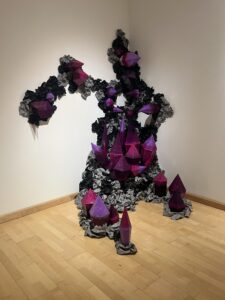
Untitled
Alexa Szuder, ‘24
Untitled, 2022
Resin and clay
My project is important to me because I am representing the beauty of life in a different way. Rather than using real plants and flowers I made replicas of these things out of resin. I wanted to show that even if something isn’t physically living, it can still be beautiful. I chose a variety of nice colors to communicate positive energy. This piece is showcased on the wall, spread out to show you if you look at life in a positive way, happiness will spread and hopefully infect others.
My love for plants comes from my grandma because she worked in a greenhouse and would take me there to show me the things they were growing. It was always so beautiful. I wanted to capture that scene but with flowers that would last a lifetime.
There is another part to my project that is made of clay. These plants are monochrome gray. They are in a box on the ground because it represents the negative way people take on life. I wanted to enclose the negativity so the positive side could really show through.
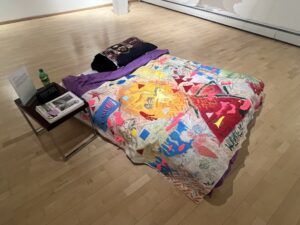
A Bouncing Body and a Busy Brain
Alexis Sevrey, ‘23
With Hiking Comes Appreciation, 2022
Photo transfers, wood, glass jars, collected artifacts from various hikes
Gratitude is the quality of being thankful; readiness to show appreciation for and to return kindness. It helps people feel more positive emotions, relish good experiences, improve their health, deal with adversity, and build strong relationships. Hiking and spending time in nature has been part of my self-care routine and hiking is where I feel most alive. It is a way to slow down, be present in the moment, and practice gratitude. Gratitude hikes are an activity that can promote a positive mindset and also help manifest goals.
Building off of my preferred choice of media, photography, the three wood panels consist of photos that were transferred onto the panel. The images are from hikes I’ve been on and things that caught my eye during those hikes arranged into a collage representing a journal or scrapbook. Additionally, the mason jars include sticks, leaves, pinecones, and other various items in nature collected from gratitude hikes. These together create a fictional trailhead map that is a guide for an imagined hike. Through collage and assemblage, I was able to explore a wide range of photographs and objects while allowing the viewer to connect with the artwork, creating their own story.
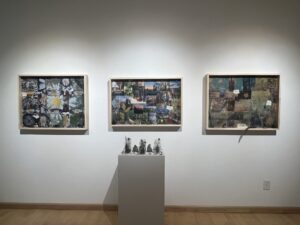
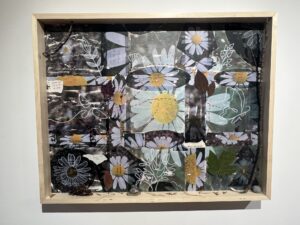
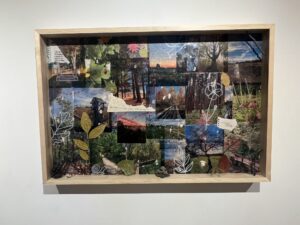
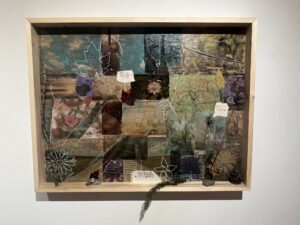
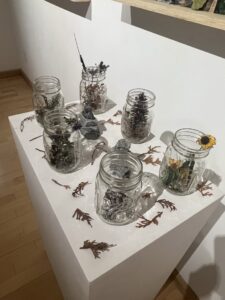
Alyssa LaMartina, ‘23
Under the Surface, 2022
Cardboard and papier mache, plastic soda can holders, plastic straws, plastic bags, bottle caps, and tabs
The subject of my work is plastic pollution and the effect it has on indigenous marine life, specifically focusing on the sea turtle. In order to demonstrate my point, I have collected trash from local beaches in Buffalo, NY, to use in the realization of the pieces. The purpose is to represent how sea turtles are not only living amongst this pollution, but ultimately perishing from their encounters with it.
The materials utilized to construct my shells are cardboard and papier mache. I have attached common plastic items found in our waterways and beaches to the shells themselves. These include soda can holders, plastic straws, plastic bags, bottle caps and tabs, etc. I painted three turtle shells to each resemble one of the seven different sea turtle classifications. The three species I have chosen to represent are the Leatherback, Hawksbill, and Kemp’s Ridley as they are the most endangered of the group as a whole. Lastly, I included a print I made that goes into details on statistics, research, and facts about my work.
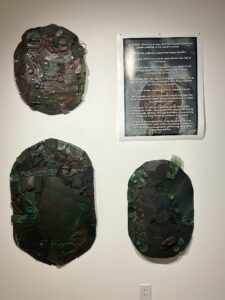
Under the Surface
Destiny Caceres, ‘24
Fly Home, 2022
Cardboard, paper, acrylic paint, colored pencils, foil stars, feathers
The idea for this project is largely based on a poem I wrote when I was feeling at my lowest and most insecure. The poem was very sad and negative, but it was an honest reflection of how I was feeling at the time. I know I wanted to create my mixed media project off of this writing as it was one of the most personal poems I’ve ever composed. I knew, however, that I wanted to give the artwork a somewhat optimistic tone. If my poem was the negative origin, I wanted this project to be its positive counterpart.
Issues of representation are central to my work. I made the center of my project a black woman who, in many ways, represents me. The golden fractures running across her face symbolize that she is imperfect. The cracks are based on the Japanese art of kintsugi, which embraces the belief that there is beauty in our imperfections and these things often make us more beautiful and unique. I added clouds to represent the wishes I have for myself.
I used ordinary materials like cardboard, paper, acrylic paint, colored pencils, and feathers because they are easily accessible, easy to work with, and I feel like they tie into my theme of imperfections. These materials are so mundane that they are often overlooked and seen as cheap, but if given the chance, they can make something really amazing. Overall, I want this project to be a reminder to myself and to others that we are fine just the way we are.
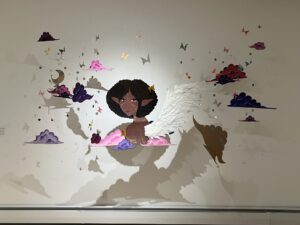
Fly Home
Sarah Salisbury, ‘25
Lone Wolf, 2022
Fabric, needle-felting
My project focuses on the concept of a lone wolf. The wolf is shown all by itself, but it exhibits a sense of comfort with being solitary.
The forest-like setting is shown on two small displays that are in front of the wolf. These displays show plants, from flowers to mushrooms, and a few other animals. The focus of the pieces was to show the feeling of being okay or comfortable with being alone and not sad.
The materials that were used to create the wolf are hand-cut fragments of different colored and patterned fabrics. For the background, I used dark, neutral colors, to create a night sky. I also included black tulle fabric with threads of metallic gold to all the background pieces. For the forest discs, I wrapped Styr two Styrofoam forms in needle-felted green wool. I also created mushrooms, flowers, and a few animals using the needle-felting technique.
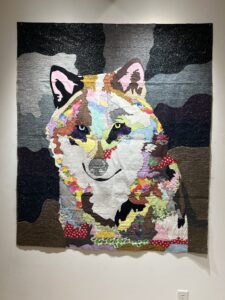
Lone Wolf
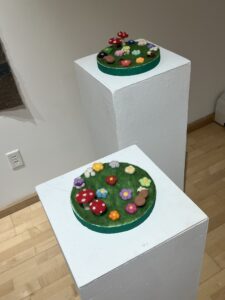
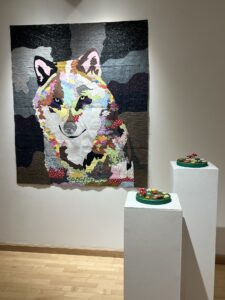
Valerie Diaz, ‘23
A Bouncing Body and a Busy Brain, 2022
Canvas, fabric, paint, oil pastels, markers, crayons
I tried my best to respond to represent the symptoms of ADHD that I experience in this piece. Even at the last moments of the night, my mind and body regularly race ceaselessly. The same goes for problems of the day; they lay like a rock on the fore-front and back of my mind. This also happens when I am trying to be creative. I regularly find myself paralyzed with indecision as I cannot make a choice about how to best proceed.
In an attempt to convey this experience, I chose to use a bed as the base of the piece. I covered the linens in marks and sketches that are from a collection of sketchbook drawings and freeform and connected patterns. I attached fabric pieces as well in an effort to more clearly convey a sense of chaos. The work is intended to be a strange mixture of playful and heavy and uncomfortable – bright colors, mixed with dark colors, and uncomfortable imagery.

A Bouncing Body and a Busy Brain
